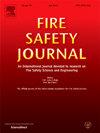Systems thinking in road tunnel safety: Feasibility of evacuation shelters for single-tube road tunnels
IF 3.4
3区 工程技术
Q2 ENGINEERING, CIVIL
引用次数: 0
Abstract
The self-rescue principle is fundamental for ensuring tunnel user safety during fires. Major fires in European road tunnels in the late 1990s and early 2000s highlighted the difficulties of evacuating single-tube tunnels with bi-directional traffic and longitudinal ventilation, resulting in an increased emphasis on facilitating self-rescue in road tunnels.
This article explores the feasibility of shelters, abbreviated to SWETO, as an element in the evacuation system for existing single-tube road tunnels with bi-directional traffic and longitudinal ventilation. The study is a response to recent years’ increased interest in the concept in Norway. Integrating SWETOs presents both engineering and sociotechnical challenges. Functional requirements and solutions are lacking and need developing. However, it is argued that available knowledge supports the concept. A gradual integration of SWETOs in selected high-risk road tunnels is proposed through pilot projects.
To increase our understanding of SWETOs effectiveness and limitations, knowledge-generating activities such as pilot projects and targeted research are crucial. These efforts should focus on their design, implementation, operation and maintenance to ensure functionality during emergencies. By addressing these aspects, SWETOs can become a valuable component of tunnel safety systems, enhancing the resilience of road tunnels and protecting tunnel users in critical situations.
道路隧道安全的系统思考:单管道路隧道疏散掩体的可行性
火灾发生时,自救原则是保障隧道使用者安全的根本。20世纪90年代末和21世纪初欧洲公路隧道的重大火灾凸显了双向交通和纵向通风的单管隧道疏散的困难,导致人们越来越重视促进公路隧道的自救。本文探讨了在现有的具有双向交通和纵向通风的单管道路隧道中,避难所(简称SWETO)作为疏散系统要素的可行性。这项研究是对近年来挪威对这一概念越来越感兴趣的回应。集成sweto提出了工程和社会技术方面的挑战。缺乏功能需求和解决方案,需要开发。然而,有人认为现有的知识支持这一概念。建议通过试点项目,在选定的高风险道路隧道中逐步整合SWETOs。为了提高我们对sweto的有效性和局限性的理解,诸如试点项目和有针对性的研究等知识生成活动至关重要。这些努力应侧重于其设计、实施、操作和维护,以确保在紧急情况下的功能。通过解决这些问题,SWETOs可以成为隧道安全系统的重要组成部分,增强公路隧道的弹性,并在危急情况下保护隧道用户。
本文章由计算机程序翻译,如有差异,请以英文原文为准。
求助全文
约1分钟内获得全文
求助全文
来源期刊

Fire Safety Journal
工程技术-材料科学:综合
CiteScore
5.70
自引率
9.70%
发文量
153
审稿时长
60 days
期刊介绍:
Fire Safety Journal is the leading publication dealing with all aspects of fire safety engineering. Its scope is purposefully wide, as it is deemed important to encourage papers from all sources within this multidisciplinary subject, thus providing a forum for its further development as a distinct engineering discipline. This is an essential step towards gaining a status equal to that enjoyed by the other engineering disciplines.
 求助内容:
求助内容: 应助结果提醒方式:
应助结果提醒方式:


